Age-associated impaired plasmacytoid dendritic cell functions lead to decreased CD4 and CD8 T cell immunity
- PMID: 20953722
- PMCID: PMC3168606
- DOI: 10.1007/s11357-010-9191-3
Age-associated impaired plasmacytoid dendritic cell functions lead to decreased CD4 and CD8 T cell immunity
Abstract
Increased susceptibility to infections, particularly respiratory viral infections, is a hallmark of advancing age. The underlying mechanisms are not well understood, and there is a scarcity of information regarding the contribution of the innate immune system, which is the first line of defense against infections. In the present study, we have investigated the effect of advancing age on plasmacytoid dendritic cell (PDC) function because they are critical in generating a robust antiviral response via the secretion of interferons (IFN). Our results indicate that PDCs from the aged are impaired in their capacity to secrete IFN-I in response to influenza virus and CPG stimulation. Additionally, we observed a severe reduction in the production of IFN-III, which plays an important role in defense against viral infections at respiratory mucosal surfaces. This reduction in IFN-I and IFN-III were a result of age-associated impaired phosphorylation of transcription factor, IRF-7. Furthermore, aged PDCs were observed to be impaired in their capacity to induce perforin and granzyme in CD8 T cells. Comparison of the antigen-presenting capacity of aged PDC with young PDC revealed that PDCs from aged subjects display reduced capacity to induce proliferation and IFN-gamma secretion in CD4 and CD8 T cells as compared with PDCs from young subjects. In summary, our study demonstrates that advancing age has a profound effect on PDC function at multiple levels and may therefore, be responsible for the increased susceptibility to infections in the elderly.
Figures
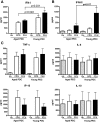
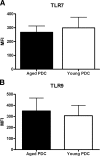
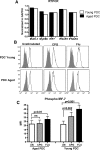
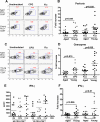
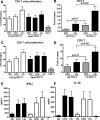
Similar articles
-
Impaired secretion of interferons by dendritic cells from aged subjects to influenza : role of histone modifications.Age (Dordr). 2013 Oct;35(5):1785-97. doi: 10.1007/s11357-012-9477-8. Epub 2012 Sep 25. Age (Dordr). 2013. PMID: 23007963 Free PMC article.
-
HMGB1 Is Involved in IFN-α Production and TRAIL Expression by HIV-1-Exposed Plasmacytoid Dendritic Cells: Impact of the Crosstalk with NK Cells.PLoS Pathog. 2016 Feb 12;12(2):e1005407. doi: 10.1371/journal.ppat.1005407. eCollection 2016 Feb. PLoS Pathog. 2016. PMID: 26871575 Free PMC article.
-
Human plasmacytoid dendritic cells efficiently cross-present exogenous Ags to CD8+ T cells despite lower Ag uptake than myeloid dendritic cell subsets.Blood. 2013 Jan 17;121(3):459-67. doi: 10.1182/blood-2012-06-435644. Epub 2012 Dec 4. Blood. 2013. PMID: 23212525
-
Role of dendritic cells in innate and adaptive immune response in human aging.Exp Gerontol. 2014 Jun;54:47-52. doi: 10.1016/j.exger.2013.12.009. Epub 2013 Dec 24. Exp Gerontol. 2014. PMID: 24370374 Review.
-
Plasmacytoid dendritic cells: recent progress and open questions.Annu Rev Immunol. 2011;29:163-83. doi: 10.1146/annurev-immunol-031210-101345. Annu Rev Immunol. 2011. PMID: 21219184 Free PMC article. Review.
Cited by
-
IFN production ability and healthy ageing: mixed model analysis of a 24 year longitudinal study in Japan.BMJ Open. 2013 Jan 11;3(1):e002113. doi: 10.1136/bmjopen-2012-002113. BMJ Open. 2013. PMID: 23315513 Free PMC article.
-
Role of Immune Aging in Susceptibility to West Nile Virus.Methods Mol Biol. 2016;1435:235-47. doi: 10.1007/978-1-4939-3670-0_18. Methods Mol Biol. 2016. PMID: 27188562 Free PMC article. Review.
-
IFN Lambda Deficiency Contributes to Severe COVID-19 Outcomes.Int J Mol Sci. 2024 Sep 30;25(19):10530. doi: 10.3390/ijms251910530. Int J Mol Sci. 2024. PMID: 39408857 Free PMC article.
-
Age and Periodontal Health - Immunological View.Curr Oral Health Rep. 2018 Dec;5(4):229-241. doi: 10.1007/s40496-018-0202-2. Epub 2018 Nov 7. Curr Oral Health Rep. 2018. PMID: 30555774 Free PMC article.
-
Counteracting Immunosenescence-Which Therapeutic Strategies Are Promising?Biomolecules. 2023 Jul 6;13(7):1085. doi: 10.3390/biom13071085. Biomolecules. 2023. PMID: 37509121 Free PMC article. Review.
References
-
- Agrawal A, Agrawal S, Cao JN, Su H, Osann K, Gupta S. Altered innate immune functioning of dendritic cells in elderly humans: a role of the phosphoinositide 3-kinase-signaling pathway. J Immunol. 2007;178(11):6912–6922. - PubMed
-
- Ank N, West H, Bartholdy C, Eriksson K, Thomsen AR, Paludan SR. Lambda interferon (IFN-lambda), a type III IFN, is induced by viruses and IFNs and displays potent antiviral activity against select virus infections in vivo. J Virol. 2006;80(9):4501–4509. doi: 10.1128/JVI.80.9.4501-4509.2006. - DOI - PMC - PubMed
-
- Ank N, Iversen MB, Bartholdy C, Staeheli P, Hartmann R, Jensen UB, Dagnaes-Hansen F, Thomsen AR, Chen Z, Haugen H, Klucher K, Paludan SR. An important role for type III interferon (IFN-λ/IL-28) in TLR-induced antiviral activity. J Immunol. 2008;180(4):2474–2485. - PubMed
Publication types
MeSH terms
Grants and funding
LinkOut - more resources
Full Text Sources
Medical
Research Materials
